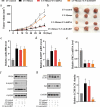Methionine represses the autophagy of gastric cancer stem cells via promoting the methylation and phosphorylation of RAB37
- PMID: 32926650
- PMCID: PMC7646514
- DOI: 10.1080/15384101.2020.1814044
Methionine represses the autophagy of gastric cancer stem cells via promoting the methylation and phosphorylation of RAB37
Abstract
This study focused on the role of methionine (MET) in the autophagy of gastric cancer stem cells (GCSCs) and aims to elaborate its regulatory mechanism. In the present study, the GCSCs were isolated from human gastric cancer cell lines using an anti-CD44 antibody, and then cultured in MET+ homocysteine (HCY)- or MET-HCY+ medium. In MET+HCY-treated GCSCs, autophagy was suppressed, the methylation and phosphorylation of RAB37 were elevated, and miR-200b expression was down-regulated. Lentiviral vector (LV-) carrying methionine-γ lyase (an enzyme that could specifically lyse MET; Metase) promoted autophagy, reduced the methylation and phosphorylation of RAB37, and up-regulated miR-200b expression in MET+HCY--treated GCSCs. Then, we found that miR-200b suppressed the expression of protein kinase C α (PKCα), a protein that could inactivate RAB37 through promoting its phosphorylation. LV-Metase down-regulated RAB37 phosphorylation via miR-200b/PKCα, thus promoting the RAB37-mediated autophagy and suppressing cell viability in MET+HCY-treated GCSCs. Finally, the in vivo study proved that LV-Metase treatment inhibited tumor growth through up-regulating RAB37 expression. In conclusion, MET suppressed RAB37 expression via enhancing its methylation and suppressed RAB37 activity via miR-200b/PKCα axis, thus repressing RAB37-mediated autophagy in GCSCs. The supplementation of Metase lysed MET, thus inducing the autophagy of GCSCs and inhibiting tumor growth.
Keywords: Methionine; RAB37; autophagy; gastric cancer stem cells; methionine-γ lyase.
Conflict of interest statement
No potential conflict of interest was reported by the authors.
Figures







Similar articles
-
DNA-methylation-mediated silencing of miR-7-5p promotes gastric cancer stem cell invasion via increasing Smo and Hes1.J Cell Physiol. 2020 Mar;235(3):2643-2654. doi: 10.1002/jcp.29168. Epub 2019 Sep 13. J Cell Physiol. 2020. PMID: 31517391
-
Xiaotan Sanjie decoction attenuates tumor angiogenesis by manipulating Notch-1-regulated proliferation of gastric cancer stem-like cells.World J Gastroenterol. 2014 Sep 28;20(36):13105-18. doi: 10.3748/wjg.v20.i36.13105. World J Gastroenterol. 2014. PMID: 25278704 Free PMC article.
-
Hyaluronic acid-modified polyamidoamine dendrimer G5-entrapped gold nanoparticles delivering METase gene inhibits gastric tumor growth via targeting CD44+ gastric cancer cells.J Cancer Res Clin Oncol. 2018 Aug;144(8):1463-1473. doi: 10.1007/s00432-018-2678-5. Epub 2018 Jun 1. J Cancer Res Clin Oncol. 2018. PMID: 29858680 Free PMC article.
-
The potential of methioninase for cancer treatment.Biochim Biophys Acta Rev Cancer. 2024 Jul;1879(4):189122. doi: 10.1016/j.bbcan.2024.189122. Epub 2024 May 23. Biochim Biophys Acta Rev Cancer. 2024. PMID: 38796027 Review.
-
Targeting Gastric Cancer Stem Cells to Enhance Treatment Response.Cells. 2022 Sep 10;11(18):2828. doi: 10.3390/cells11182828. Cells. 2022. PMID: 36139403 Free PMC article. Review.
Cited by
-
Methionine restriction enhances the chemotherapeutic sensitivity of colorectal cancer stem cells by miR-320d/c-Myc axis.Mol Cell Biochem. 2022 Jul;477(7):2001-2013. doi: 10.1007/s11010-022-04416-1. Epub 2022 Apr 8. Mol Cell Biochem. 2022. PMID: 35394639
-
Upregulation of E-cadherin by the combination of methionine restriction and HDAC2 intervention for inhibiting gastric carcinoma metastasis.Acta Biochim Biophys Sin (Shanghai). 2024 Jan 25;56(1):62-70. doi: 10.3724/abbs.2023244. Acta Biochim Biophys Sin (Shanghai). 2024. PMID: 38143381 Free PMC article.
-
The Role of Methionine Restriction in Gastric Cancer: A Summary of Mechanisms and a Discussion on Tumor Heterogeneity.Biomolecules. 2024 Jan 30;14(2):161. doi: 10.3390/biom14020161. Biomolecules. 2024. PMID: 38397398 Free PMC article. Review.
-
Per- and polyfluoroalkyl substances, epigenetic age and DNA methylation: a cross-sectional study of firefighters.Epigenomics. 2021 Oct;13(20):1619-1636. doi: 10.2217/epi-2021-0225. Epub 2021 Oct 21. Epigenomics. 2021. PMID: 34670402 Free PMC article.
-
Crosstalk between autophagy and CSCs: molecular mechanisms and translational implications.Cell Death Dis. 2023 Jul 8;14(7):409. doi: 10.1038/s41419-023-05929-3. Cell Death Dis. 2023. PMID: 37422448 Free PMC article. Review.
References
Publication types
MeSH terms
Substances
LinkOut - more resources
Full Text Sources
Other Literature Sources
Medical
Molecular Biology Databases
Miscellaneous
